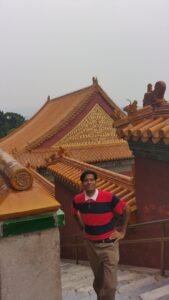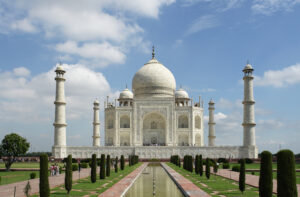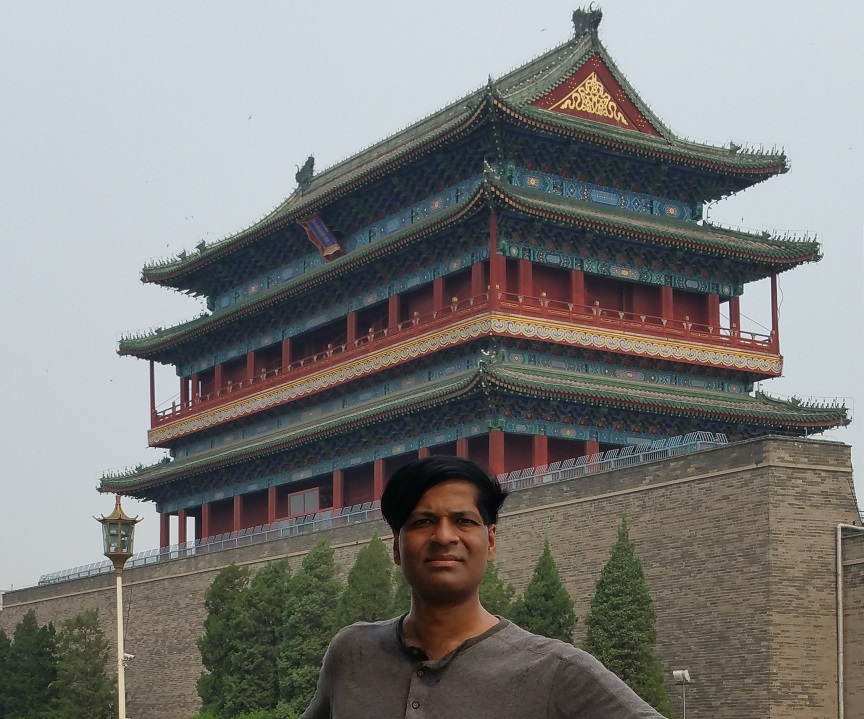
Tiananmen Square or Tian’anmen Square (天安门 Pinyin: Tiān’ānmén) is a city square in the centre of Beijing, China, named after the Tiananmen (‘Gate of Heavenly Peace’) located to its north, separating it from the Forbidden City. The Tiananmen (“Gate of Heavenly Peace”) is a gate in the wall of the Imperial City, was built in 1415 during the Ming dynasty. The square contains the Monument to the People’s Heroes, the Great Hall of the People, the National Museum of China, and the Mausoleum of Mao Zedong. Mao Zedong proclaimed the founding of the People’s Republic of China in the square on October 1, 1949 – the anniversary of this event is still observed there.Tiananmen Square is within the top ten largest city squares in the world (440,500 m2 – 880×500 m or 109 acres – 960×550 yd)

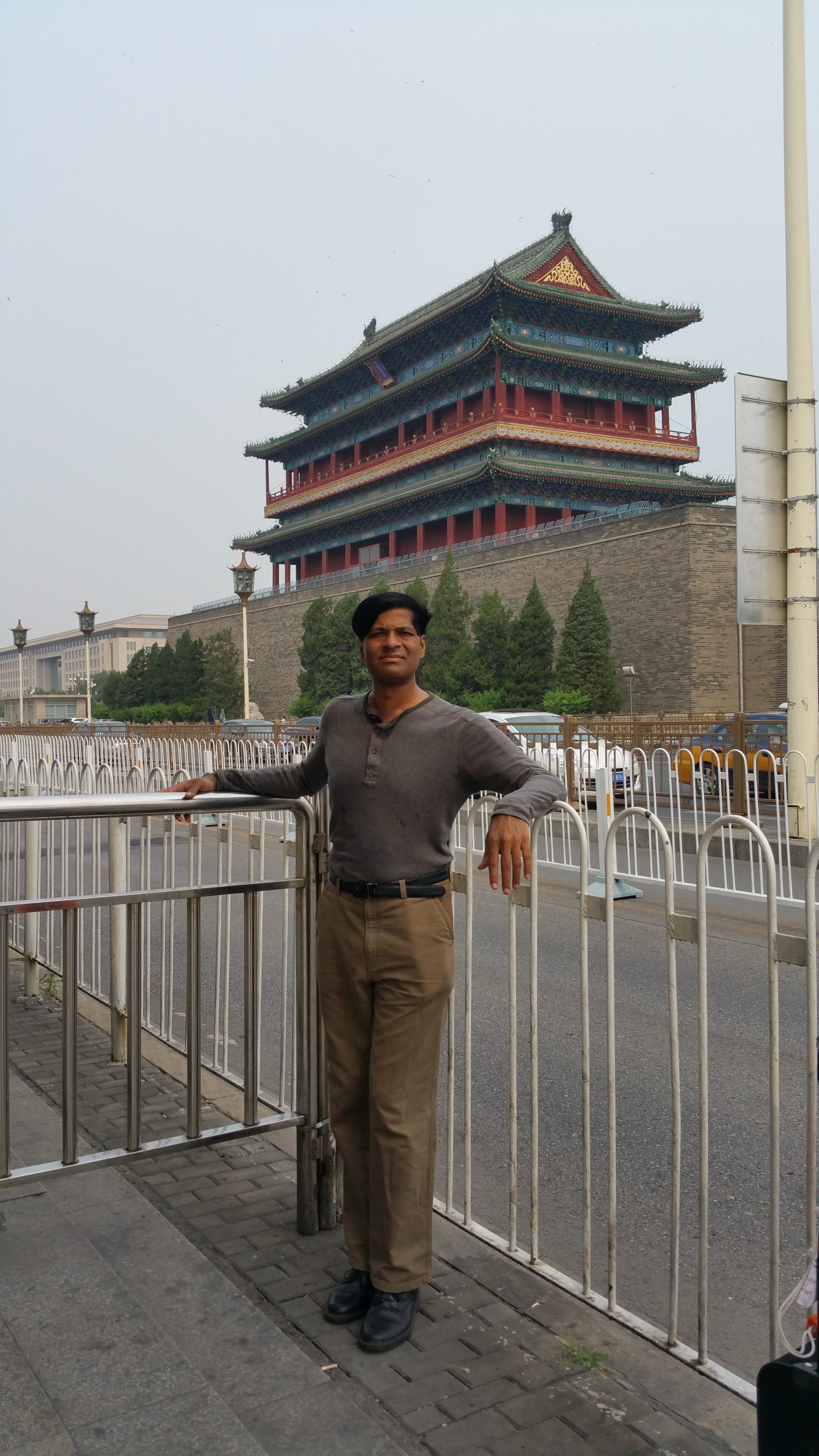
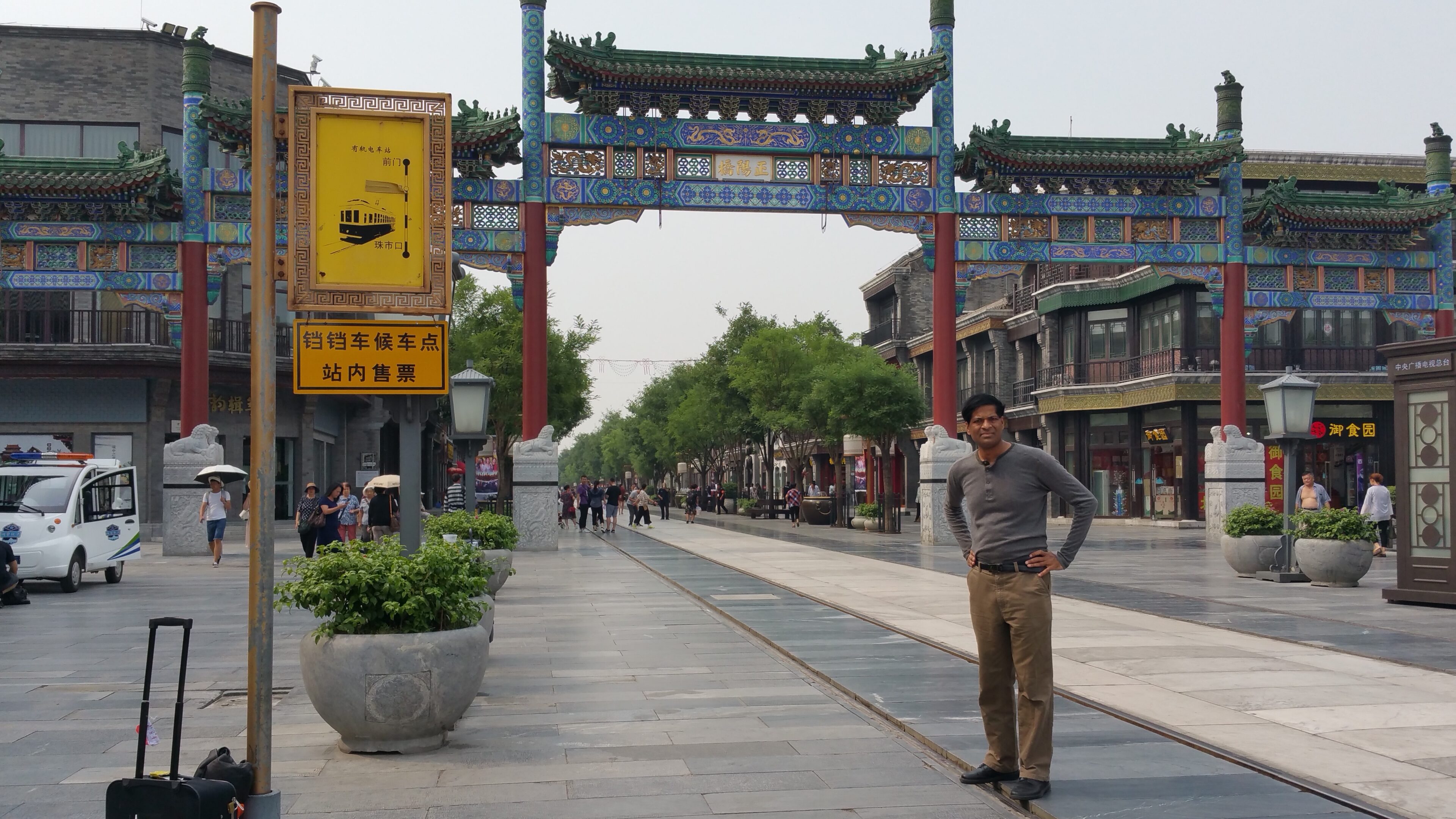
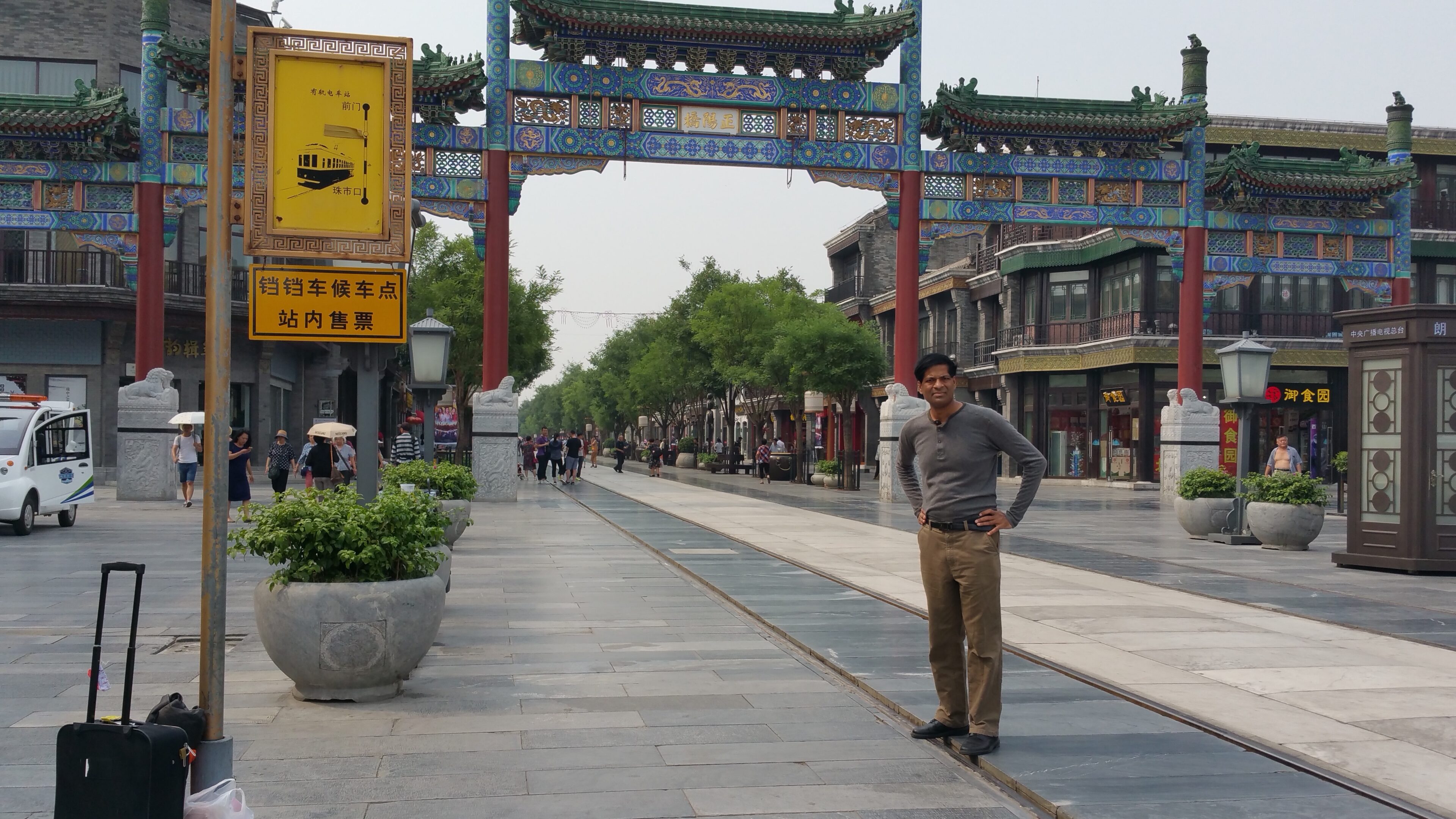
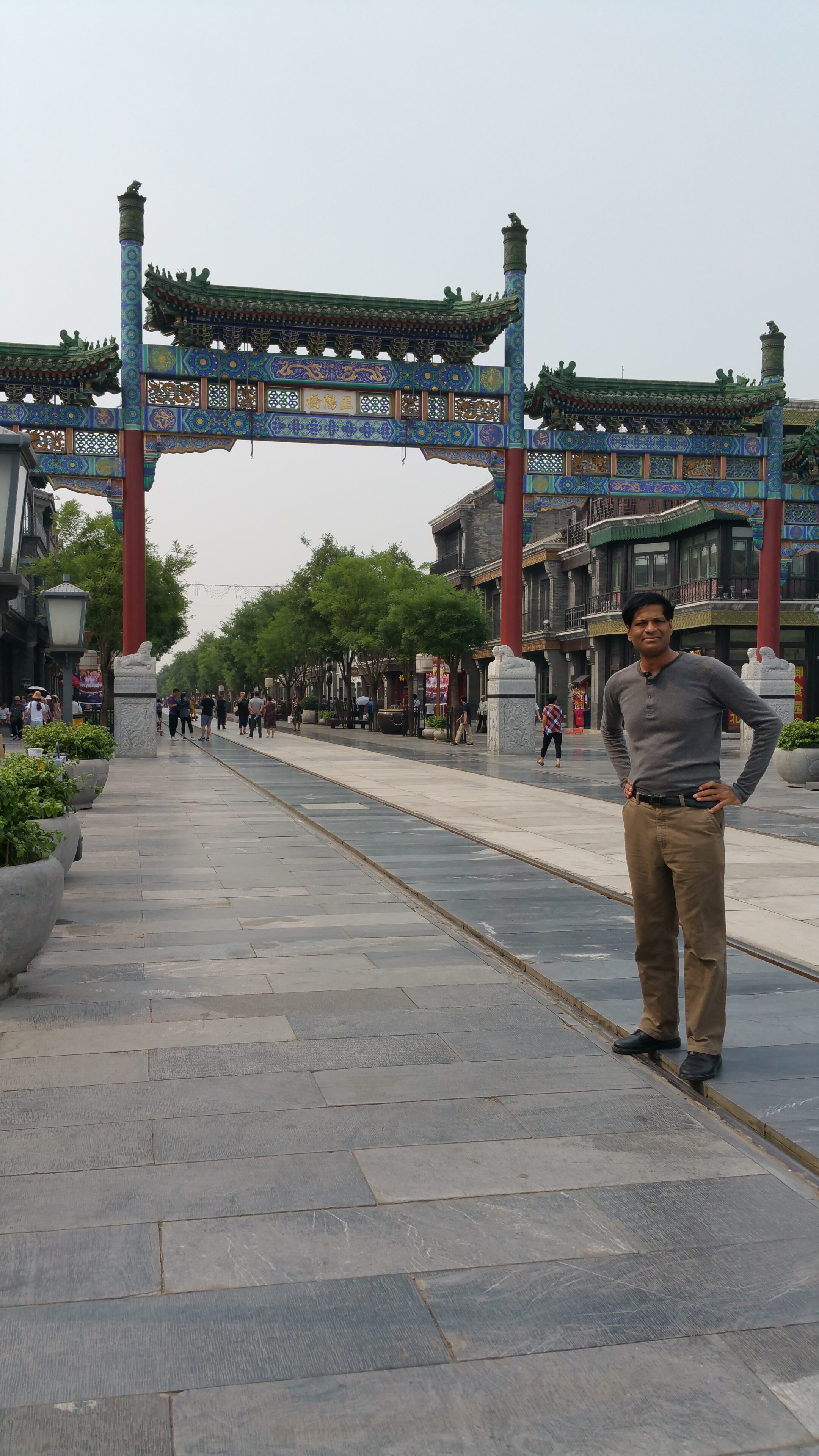
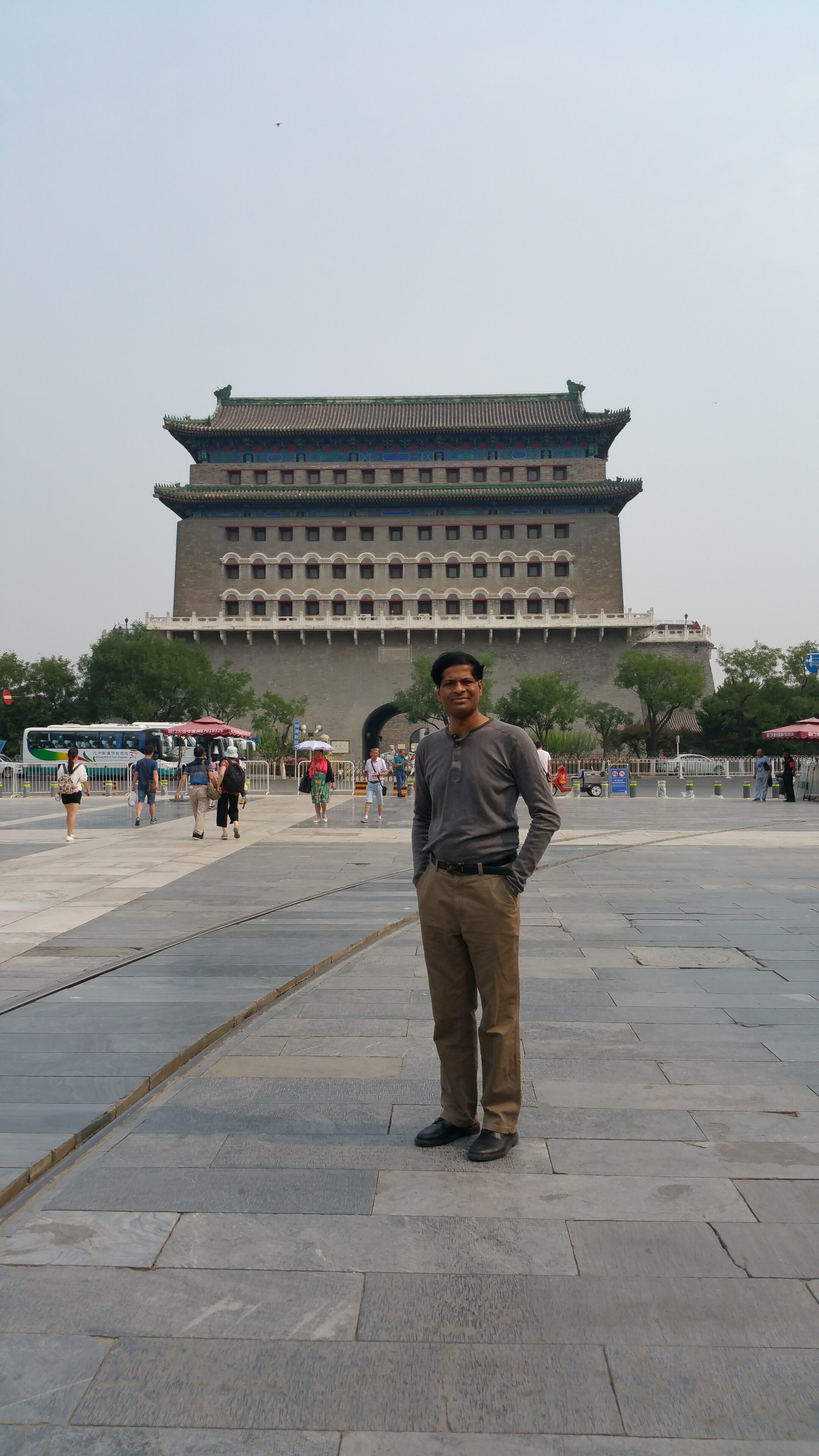
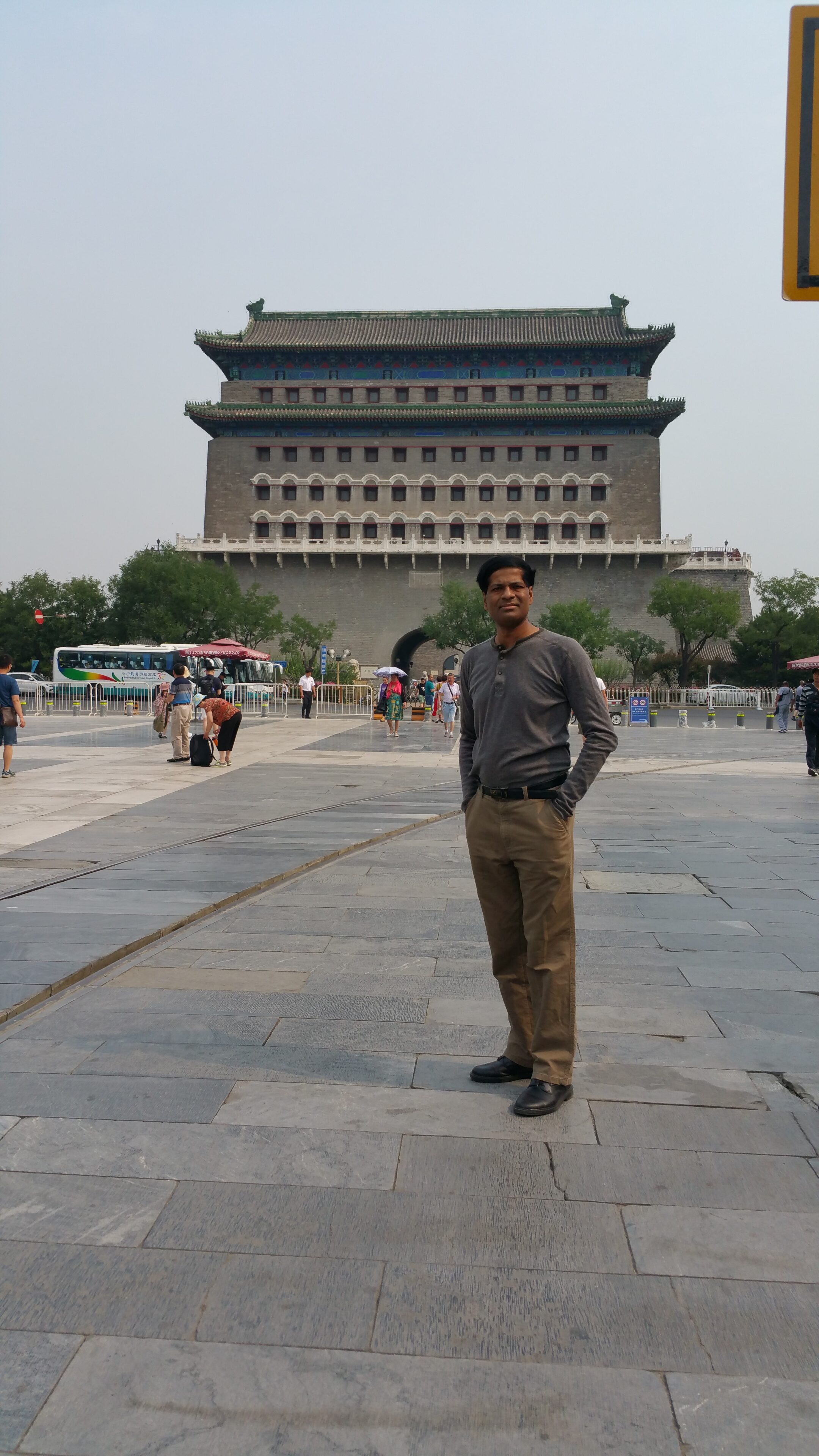
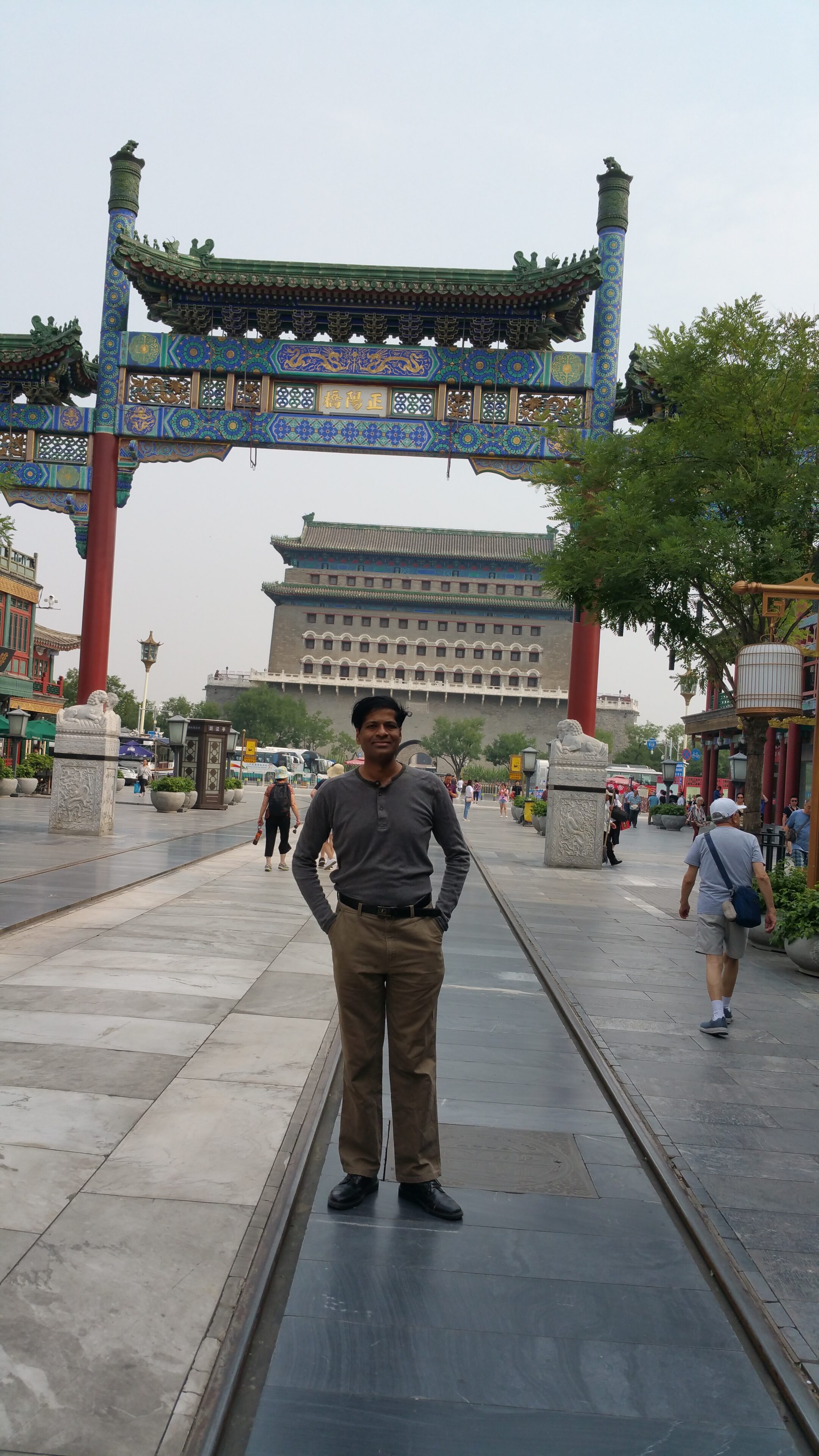
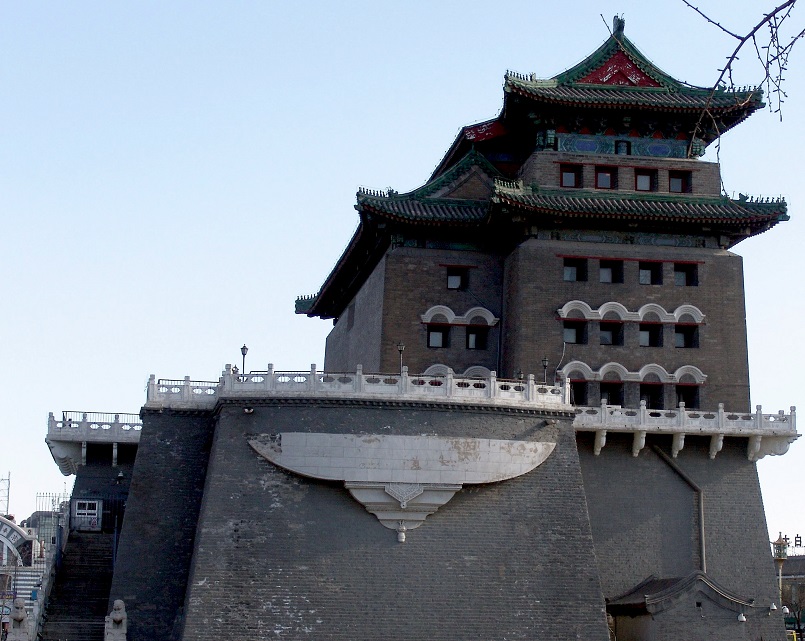
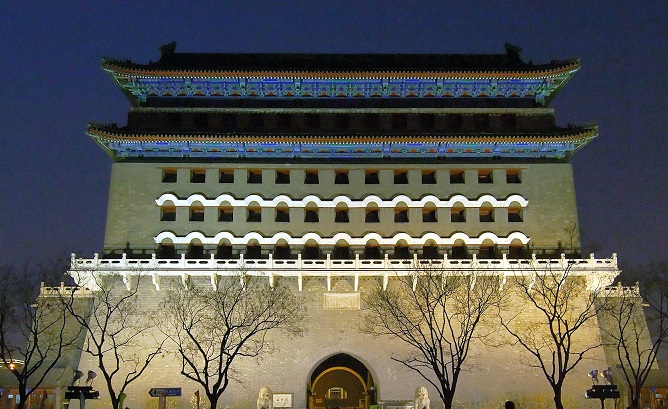
WHAT IS THE TIAN´AN MEN ?

- The Tiananmen (also Tian’anmen, Tienanmen, T’ien-an Men) or the Gate of Heavenly Peace, is a monumental gate in the centre of Beijing, China and widely used as a national symbol
- First built during the Ming dynasty in 1420, Tiananmen was the entrance to the Imperial City, within which the Forbidden City was located
- Tiananmen is located to the north of Tiananmen Square, separated from the plaza by Chang’an Avenue
DESCRIBE THE TIAN´AN MEN
- The building is 66 metres (217 ft) long, 37 metres (121 ft) wide and 32 metres (105 ft) high
- Like other official buildings of the empire, the gate has unique imperial roof decorations
- In front of the gate are two lions standing in front of the gate and two more guarding the bridges
- In Chinese culture, lions are believed to protect humans from evil spirits
- Two stone columns, called huabiao, each with an animal (hou) on top of it, also stand in front of the gate
- Originally, these installations were designed for commoners to address their grievances by writing or sticking up petitions on the columns
- However, the examples in front of the Imperial City were purely decorative and instead connoted the majesty of the imperial government
WHAT ARE THE PLACARDS ON THE TIAN´AN MEN ?
- The western and eastern walls have giant placards
- The left one reads “Long Live the People’s Republic of China” (中华人民共和国万岁; Zhōnghuá Rénmín Gònghéguó wànsuì)
- While the right one reads “Long Live the Great Unity of the World’s Peoples” (世界人民大团结万岁; Shìjiè rénmín dà tuánjié wànsuì)
- Both placards were changed to use simplified Chinese instead of traditional Chinese characters in 1964
- The phrasing has significant symbolic meaning, as the phrase used for long live, like the Imperial City itself, was traditionally reserved for Emperors of China, but is now available to the common people
- The reviewing stands in the foreground are used on International Workers Day (May Day) and on the National Day (October 1) of the People’s Republic of China
- In front of the stands is the Imperial City’s moat, still filled with water but now containing decorative illuminated fountains
- In ancient times, the Tiananmen was among the most important gates encountered when entering Beijing’s Imperial City along with the Qianmen, the Gate of China
- Proceeding further inward, the next gate is the ‘Upright Gate’, identical in design to the Tian’anmen
- Behind it is the southern entrance of the Forbidden City itself, known as the Meridian Gate
- Due to its historical significance, Tiananmen is featured on the National Emblem of the People’s Republic of China. It has also been featured in the designs of stamps and coins issued by the People’s Republic of China
-
 Tian´ An Men inscribed on National Emblem of the People´s Republic of China (PRC)
Tian´ An Men inscribed on National Emblem of the People´s Republic of China (PRC)
DESCRIBE THE TIAN´AN MEN SQUARE
- Mao Zedong proclaimed the founding of the People’s Republic of China in the square on October 1, 1949 – The anniversary of this event is still observed there
- Tiananmen Square is within the top ten largest city squares in the world (440,500 m2 – 880×500 m or 109 acres)
- It has great cultural significance as it was the site of several important events in Chinese history
- Used as a massive meeting place since its creation, its flatness is contrasted by the 38-metre high Monument to the People’s Heroes, and the Mausoleum of Mao Zedong
- The square lies between two ancient, massive gates : The Tiananmen to the north and the Zhengyangmen (better known as Qianmen) to the south
Along the west side of the square is the Great Hall of the People
 Above – The Great Hall of the People on the west side of the Square
Above – The Great Hall of the People on the west side of the Square Above – Zhengyangmen Gate Tower marking the south end of Tiananmen Square
Above – Zhengyangmen Gate Tower marking the south end of Tiananmen Square

 Monument to the People’s Heroes
Monument to the People’s Heroes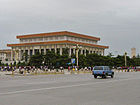 Mausoleum of Mao Zedong
Mausoleum of Mao Zedong Monument in front of Mao’s Mausoleum on Tiananmen Square
Monument in front of Mao’s Mausoleum on Tiananmen Square- Along the east side is the National Museum of China (dedicated to Chinese history predating 1919)
- Chang’an Avenue, which is used for parades, lies between the Tian’anmen and the square
- Trees line the east and west edges of the Square, but the square itself is open, with neither trees nor benches
- The square is lit with large lamp posts
ZHENGYANG MEN (QIANMEN)

- Qianmen ( 前门 前門 Qiánmén literally : ‘Front Gate’) is the colloquial name for Zhengyangmen ( 正阳门正陽門 Zhèngyángmén) – A gate in Beijing’s historic city wall
- The gate is situated to the south of Tiananmen Square and once guarded the southern entry into the Inner City
- Although much of Beijing’s city walls were demolished – Zhengyangmen remains an important geographical marker of the city
- The city’s central north-south axis passes through Zhengyangmen’s main gate
- Zhengyangmen was first built in 1419 during the Ming dynasty and once consisted of the gatehouse proper and an archery tower, which were connected by side walls and together with side gates, formed a large barbican
- The gate guarded the direct entry into the imperial city
- The city’s first railway station, known as the Qianmen Station, was built just outside the gate
- At 42 metres high, the Zhengyangmen gatehouse was, and remains, the tallest of all gates in Beijing’s city wall
- Qianmen remains one of the enduring symbols of old Beijing
- The Zhengyangmen is situated on the central north-south axis of Beijing
- The kilometre zero point for highways in China is located just outside the Zhengyangmen Gate
- It is marked with a plaque in the ground, with the four cardinal points, four animals, and “Zero Point of Highways, China” in English and Chinese
DRUM TOWER (GU LOU)
BELL TOWER (ZHONG LOU)

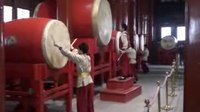 Performance at the Drum Tower
Performance at the Drum Tower The Bell Tower
The Bell Tower- Gulou (鼓楼 : Gǔlóu) or Drum Tower of Beijing, is situated at the northern end of the central axis of the Inner City to the north of Di’anmen Street
- Originally built for musical reasons, it was later used to announce the time and is now a tourist attraction
- Zhonglou ( 钟楼 : Zhōnglóu) or Bell Tower of Beijing stands closely behind the drum tower
- Together, the Bell Tower and Drum Tower have panoramic views over central Beijing and before the modern era, they both dominated Beijing’s ancient skyline
BELL TOWER & DRUM TOWER : FUNCTION
- Bells and drums were musical instruments in ancient China
- Later they were used by government & communities to announce time
- The Bell and Drum towers were central to official timekeeping in China in the Yuan, Ming and Qing dynasties
- The Bell and Drum Towers continued to function as the official timepiece of Beijing until 1924, when the Beijing Coup led to the expulsion of Puyi-the last emperor of the Qing Dynasty from the Forbidden City and the adoption of western-styled clockwork for official time-keeping
- The Drum Tower was built in 1272 during the reign of Kublai Khan at which time it stood at the very heart of the Yuan capital Dadu
- Following the Beijing Coup in 1924 – Feng Yuxiang removed the official status of the towers, replacing them with western time-keeping methods, and renamed the building “Mingchilou”, or the “tower of clarifying shame”.
- The upper story of the building currently serves as the People’s Cultural Hall of the East City District
- In the 1980s, after much repair, the Bell and Drum Towers were opened to tourists
- The Drum Tower is a two-story building made of wood with a height of 47 metres
- In the upper story of the building housed 24 drums, of which only one survives
- New drums had been build to replace them
- Nearby stands the Bell Tower, a 33-metre-high edifice with gray walls and a green glazed roof
BEIJING IN BRIEF
THE CAPITAL OF THE PEOPLE´S REPUBLIC OF CHINA (PRC)
- Beijing (Peking) is the capital of the People’s Republic of China
- BEIJING is the world’s most populous capital city
- China has 55 UNESCO Eorld heritage sites (as of 2020) and Beijing has seven UNESCO World Heritage Sites — the Forbidden City, Temple of Heaven, Summer Palace, Ming Tombs, Zhoukoudian and parts of the Great Wall and the Grand Canal
- BEIJING (ETYMOLOGY) – The name Beijing, which means “Northern Capital” (from the Chinese characters 北 for north and 京 for capital), was applied to the city in 1403 during the Ming dynasty to distinguish the city from Nanjing (the “Southern Capital”)
- PEKING (ETYMOLOGY) – An older English spelling, Peking, is the postal romanization of the same two characters as they are pronounced in Chinese dialects spoken in the southern port towns first visited by European traders and missionaries
- Although Peking is no longer the common name for the city, some of the city’s older locations and facilities, such as Beijing Capital International Airport, with IATA Code PEK, and Peking University, still use the former romanization
BEIJING – HISTORY IN BRIEF
- MING DYNASTY (1368-1644), QING DYNASTY (the last imperial dynasty of China that was established in 1636) and ruled China from 1644 to 1912)
- FORBIDDEN CITY CONSTRUCTION : The construction of the new imperial residence, the Forbidden City, took from 1406 to 1420 during the reign of MING DYNASTY
BEIJING : THE FORBIDDEN CITY (PALACE MUSEUM)
- This period was also responsible for several other of the modern city’s major attractions, such as the Temple of Heaven and Tian’anmen
BEIJING TIAN TAN – THE TEMPLE OF HEAVEN
- On 28 October 1420, the city was officially designated the capital of the Ming dynasty in the same year that the Forbidden City was completed
- Beijing became the empire’s primary capital and Yingtian, also called Nanjing (southern capital), became the co-capital
- It is generally believed that Beijing was the largest city in the world for most of the 15th, 16th, 17th, and 18th centuries
- Formation of the People´s Republic of China (PRC) On 1 October 1949 – Mao Zedong announced the creation of the People’s Republic of China from atop Tian’anmen
- He restored the name of the city as the new capital, to Beijing
- Beijing is governed as a municipality under the direct administration of the central government
MODERN BEIJING
- Since the early 1980s, the urban area of Beijing has expanded greatly with the completion of the 2nd Ring Road in 1981 and the subsequent addition of the 3rd, 4th, 5th and 6th Ring Roads
- Wangfujing and Xidan have developed into flourishing shopping districts while Zhongguancun has become a major center of electronics in China
- The city spreads out in concentric ring roads
- The Second Ring Road traces the old city walls and the Sixth Ring Road connects satellite towns in the surrounding suburbs
- Tian’anmen and Tian’anmen Square are at the center of Beijing, directly to the south of the Forbidden City, the former residence of the emperors of China
- To the west of Tian’anmen is Zhongnanhai, the residence of China’s current leaders
- Chang’an Avenue, which cuts between Tiananmen and the Square, forms the city’s main east–west axis
- Beijing Municipality currently comprises 16 administrative county-level subdivisions
- Due to the concentration of state owned enterprises in the national capital, Beijing in 2013 had more Fortune Global 500 Company headquarters than any other city in the world
- six high-end economic output zones around Beijing as the primary engines for local economic growth – Zhongguancun (China’s silicon village), Beijing Financial Street in Xicheng District (Banks, Insurance, Financial services firms, regulators), Beijing Central Business District (CBD – skyscrappers), Beijing Economic and Technological Development Area (industrial), Beijing Airport Economic Zone (around Beijing Inetrnational airport), Beijing Olympic Center Zone (sports, entertainment zone)
- The city has also hosted major international events, including the 2008 Summer Olympics and the 2015 World Championships in Athletics, and was chosen to host the 2022 Winter Olympics, making it the first city to ever host both Winter and Summer Olympics
BEIJING – SIHEYUANS & HUTONGS
- Siheyuans (the city’s traditional housing style) and hutongs (the narrow alleys between siheyuans) are major tourist attractions and are common in urban Beijing
- Beijing is famous for its siheyuans, a type of residence where a common courtyard is shared by the surrounding buildings
- These courtyards are usually connected by alleys called hutongs
- The hutongs are generally straight and run east to west so that doorways face north and south for good Feng Shui
- They vary in width; some are so narrow only a few pedestrians can pass through at a time. Once ubiquitous in Beijing,
- siheyuans and hutongs are rapidly disappearing
BEIJING HUTONGS : A CLASSIC CULTURAL JOURNEY
- Three styles of architecture are predominant in urban Beijing. First, there is the traditional architecture of imperial China, second the box styled sino-soviet and modern now
BEIJING – CULTURE
- Beijing or Peking opera is a traditional form of Chinese theater well known throughout the nation
- Commonly lauded as one of the highest achievements of Chinese culture
- Beijing opera is performed through a combination of song, spoken dialogue, and codified action sequences involving gestures, movement, fighting and acrobatics
- Much of Beijing opera is carried out in an archaic stage dialect quite different from Modern Standard Chinese and from the modern Beijing dialect
- Teahouses are common in Beijing
- There are 144 museums and galleries (as of June 2008) in the city
BEIJING – MISCELLANY
LINKS TO HISTORIC SITES IN & AROUND BEIJING
BEIJING YONGHE TEMPLE (LAMA TEMPLE)
- YIHEYUAN – The Summer Palace and the Old Summer Palace both lie at the western part of the city; the former, a UNESCO World Heritage Site contains a comprehensive collection of imperial gardens and palaces that served as the summer retreats for the Qing imperial family
BEIJING YIHEYUAN : UNESCO WORLD HERITAGE SITE
- There are several sections of the UNESCO World Heritage Site Great Wall of China most notably Badaling, Jinshanling, Simatai and Mutianyu
THE GREAT WALL OF CHINA>LONGEST STRUCTURE
- Located at the outskirts of urban Beijing, but within its municipality are the Thirteen Tombs of the Ming dynasty, the lavish and elaborate burial sites of thirteen Ming emperors, which have been designated as part of the UNESCO World Heritage Site Imperial Tombs of the Ming and Qing Dynasties
MING TOMBS : UNESCO WORLD HERITAGE SITE
- Beijing has two of the world’s largest airports
- The Beijing Capital International Airport (IATA: PEK)
- Beijing Daxing International Airport – The Beijing Daxing International Airport (IATA: PKX) located 46 kilometres (29 mi) south of the city in Daxing District bordering the city of Langfang, Hebei Province, opened on 25 September 2019
- The Beijing Daxing Airport has one of the world’s largest terminal buildings and is expected to be a major airport serving Beijing, Tianjin and northern Hebei Province
BEIJING DAXING INTERNATIONAL AIRPORT : THE BIGGEST AIRPORT IN THE WORLD
- Beijing Daxing Airport is connected to the city via the Beijing–Xiong’an intercity railway, the Daxing Airport Express line of the Beijing Subway and two expressways
- Daxing Airport Express of the Beijing Subway (Chinese: 北京地铁大兴机场线; pinyin: Běijīng Dìtiě Dàxīng Jīchǎng Xiàn) is an airport rail link from Caoqiao (located at the Southern 3rd Ring Road) to the Beijing Daxing International Airport
BEIJING DAXING INTERNATIONAL AIRPORT EXPRESS
